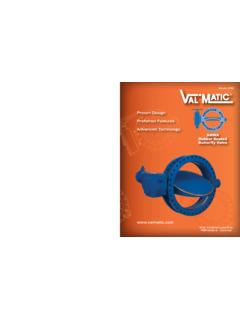Transcription of Choosing The Right Seat Material is the Most Challenging ...
1 Valve Seat & Seal Selection GuideTech Bulletin Page 180-13 Choosing The Right Seat Material is the MostChallenging Decision in ball Valve SelectionVALVE REPAIR KIT INCLUDES ALL SOFT PARTSS eats - Body Seals - Stem Packing - Thrust WasherFlanged End3PC ValvesValve Soft PartsFlo-Tite ball valves are available with a variety of seat & seal options to allow use in a widerange of general as well as special services. The soft-seated ball valves are factory testedfor tight shut-off and are built to of the most important factors affecting shut-off capability is the nature of media being handled. Service life is affected by all of the following of these factors are interrelated in actual service.
2 Maximum service life, therefore, canbe gained by reducing the severity of any of these list of seat materials has been prepared to assist the specifying engineer & the enduser in the proper seat and seal selection. This information should be used in conjunctionwith pressure temperature rating graph found in our catalog for the applicable of Pressure FluctuationDegree of Thermal FluctuationType of MediaCycling FrequencyVelocity of the MediaSpeed of Valve Seats (2)Body Seals (1) Spiral Wound 316 / GraphiteFlanged End, 2 and 3 PC Valves share the same stem Stem Seals (5)Body Seals (2)Valve Seats (2)Thrust Washers (1 or 2)OOLLfFTTTTEIIE valves & controlsTMvalves & controlsTech Bulletin Page 180A-13 STANDARD SEAT SELECTIONSSeat CodeMaterialTechnical DescriptionColorApprox.
3 Torque Addersto the standard seats indicated in catalog pageFSuper-Tek(TFM)Super-Tek, most popular seat Material used by (TFM) offers most all of the properties of PTFE with improved thermo-mechanical properties offering lower coefficient of friction for lower torques and less permeability, reduced cold flow deformation, and enhanced deformation recovery. Temperature Range -50 F to 500 seats in most all valvesTorques indicated in catalog pageKKel F(PCTFE)This Material is a fluorocarbon rubber. Kel F is a registered trademark of3M Corp. It can be used for cryogenic service at tempartures of -400 F upto 500 F at pressures up to 1500 White+50%MMetalRecommended for service with severe flashing or hydraulic shock, abrasive media or where possible trapped metal may exist.
4 Flo-Tite s metal seats arehand lapped to the ball as individually matched sets, assuring line contactbetween valve ball and seats, resulting in smooth operation and tight shut off class. Flo-Tite offers metal seats in different classes of Shut Off including Class IV, V and VI. Extreme series can reach temperature up to 1200 Class 150 +60%ANSI Class 300 +70%ANSI Class 600 +80%PPeekThis Material offers a unique combination of chemical mechanical electricaland thermal properties. The only solvents which will attack Peek is concen-trated nitric acid & sulfuric acid. It will withstand temperatures up to 600 F and pressures up to 4500 +60%QCryo-TekCryo-Tek is a form of modified PTFE, which contains bronze and other cryogenic fillers, specially suitable for LOX service.
5 Excellent seat Material for difficult applications. Temperature Range -400 F to 400 +30%RReinforcedTFEThis is produced by adding 15% fibrous glass or carbon to Virgin Teflon and has a greater pressure temperature rating than Teflon up to 420 F. They also have a better cycle life than as indicatedin literatureSStainlessFilled PTFE(S-Tek)S-Tek (stainless filled PTFE) combines the strength of metal with the lubricity of PTFE. 50% 316 powder combined with 50% PTFE. Offers the abrasion resistance of metal with higher pressure and temperature ratings than RPTFE. Temperature rating -20 to 550 / Steam rating 250 +50%TVirgin TFEThis is the most widely used seating Material and is excellent for mostservices.
6 It has excellent chemical resistance throughout valve industries and a low coefficient of friction. Temperature Range -50 F to 450 as indicatedin literatureUUHMWP olyethyleneUHMW polyethylene is used for highly radioactive materials where PTFE is not acceptable (> 104 rads ) and is rated 2 x 107 rads. These seats also meet the requirements of the tobacco industry whenever PTFE is prohibited, and are especially well-suited for handling highly abrasive Range -70 F to 200 F, not suitable for steam. OpaqueWhite+40%VDevlonDevlon Material is one of the toughest and hardest wearing thermoplastics available. It provides wear resistance, impact strength, and moisture absorp-tion properties.
7 Devlon is used in many valve seats which require a broad range of working temperatures, excellent corrosion resistance and outstanding resistance in high pressure applications. Temperature Range -50 to 350 +40% if not listed as standard Material and indicated in literatureXSuper-Tek IICarbon/Graphite Filled TFM offers exceptional chemical & heat resistance properties. It has a low coefficient of friction for lowering valve torque. It is good for service temperatures ranging from -320 F to 550 +10%YSuper-TekIIIThis is a Teflon base filled with glass amorphour carbon powder andgraphite. It has lower thermal contraction-expansion rate than PTFE and isideal for steam or thermal fluid applications up to 550 F.
8 Super-Tek III is also good for Cryogenic applications as low as -300 +40%C/FCavity FillerDesigned to reduce the possibility of contamination by entrapment ofprocess fluids in the void normally found behind the ball between the valve body in conventionally designed ball valves. Ideal for application wherecross contamination is a concern, such as paints or dyes. Available inmost seating +50% Bulletin Page 180B-13 STANDARD SEAL SELECTIONSP ressure Temperature ChartPressure Relieving &Equalizing Seat DesignSeal CodeMaterialTechnical DescriptionColorGGRAPHOILU sable from -70 to 1000 F on almost any mdeia. It is the standard seal on all fire rated valvesGreenRReinforcedTFEThis is produced by adding 15% fibrous glass to Virgin Teflon and has a greater pressure temperaturerating than Teflon.
9 They also have a better cycle life than TFEC ombines the strength of metal with the lubricity of TFE. 50% 316 powder combined with 50% TFE. Offers the abrasion resistance of metal with higher pressure and temperature ratings than RPTFE. Tem-perature rating -20 F to 550 F / Steam rating 250 SWPGrayTVirgin TFET eflon is excellent at pressures below 1500 psi & at temperatures from -20 F to 400 F. It will not withstand temperature fluctuations in excess of 200 F & are not reusable. It has excellent resistance to a wide range of is rated to 1500 psi at temperatures from -70 to 200 F. This can be used in low to medium level radiation service and in applications where fluorocarbons can not be tolerated.
10 Abrasion resistance is quite body seals are excellent at all rated pressures with a temperature range of -20 to 400 F. Viton isthe best elastomer seal for higher temperature applications, but it should not be used on WireGraphiteManufactured by spirally winding a preformed V shape SS316 metal strip and a graphite sealing filler in combination. This gasket has adequate flexibility and recovery to maintain a seal under variable and uneven loading, pressure, and temperature fluctuation, bolt stress relaxation and creep. Temperature range from -320 to +1000 seat & seal materials and sealing techniques continuously become available through our dedicated research and development programs.








